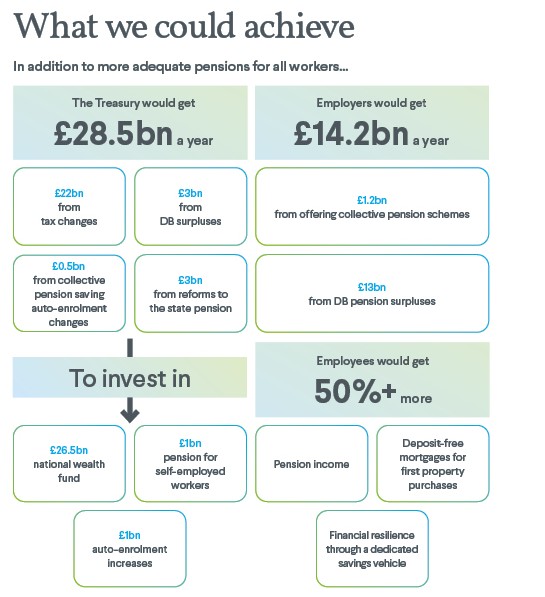£100 billion a year could be made for the UK, by the government and employers through a package of proposals to unlock money from pensions, according to a new policy paper ‘The Untapped Potential of Pensions’ launched today by Hymans Robertson. As the government makes plans for phase two of the Pensions Review, the paper outlines a raft of potential - costed - policy changes that could help the Treasury reap billions of pounds. It then outlines how these savings could be directed into investment in the UK, to finance growth and improve retirements for millions.
The proposals outlined in the paper include unlocking £22bn annually through tax changes on pensions that do not impact take home pay or pension, the development of collective pension savings, the use of DB pension surplus to gain over £400bn for UK investment and ensuring sustainable state pensions. The leading pensions and financial services firm has calculated that the Treasury could gain as much as £28.5 bn a year if all these changes were implemented while employers would benefit by up to £14.2bn. Across 10 years, and with private capital crowded in, this could create an internationally competitive £1trn UK National Wealth Fund plus the financing needed for the UK’s Net Zero Transition. It would also enable the enhancement of auto enrolment and pensions for the self-employed, while at the same time employees would gain better retirement incomes.
Auto-enrolment has been successful in getting people saving into pensions, but the current default rates aren’t enough to give people adequate retirements. The industry knows this, but most savers don’t yet; when the pension dashboards are launched this will be laid bare. Any government plans to get people on the path to adequate retirements will inevitably cost money. The paper’s bold proposals would make money for the Treasury, save money for employers and, if that money is channelled into a national wealth fund and used for pension reform, would enhance people’s financial wellbeing.
Commenting on the paper’s proposals Calum Cooper, Head of Pension Policy Innovation, Hymans Robertson says: "The promised second phase of the pensions review presents an opportunity to make lasting changes to give people financial independence in later life for as long as they live. But it’s also an opportunity to meet other important aims, such as improving equity, unlocking tens of billions of pounds annually and investing in UK economic growth at a huge scale. This is a once-in-a-generation opportunity to align pensions policy with national prosperity.
“Our proposals outline how unlocking the untapped potential in pensions could save the Treasury and employers money, while stimulating investment in the UK. It could generate the £100bn a year that is needed for 3% economic growth and our Net Zero transition. A big change requires lots of work, and this would be a huge job for the pensions industry to implement. But the risk of inaction and the opportunity is also huge; to help current and future generations of workers, and the economy. It could lead to £1trn more investment in the UK, over 10 years, while delivering better pensions for workers. Our proposals are bold, but they’d deliver financial security for workers, cost savings for employers, and a massive boost for the UK economy.”

Key Proposals from the paper
Reform Pension Taxation
Replace traditional tax relief with a flat-rate government “top-up bonus” paid into pension pots. All retirement income would then be tax-free. It would simplify the system and enable the Treasury to bring forward £22bn a year in revenue to be invested, for example, in a national wealth fund, without increasing overall tax burdens.
Unlock DB Surpluses for Growth
UK Defined Benefit schemes hold an estimated £160bn in surplus capital. With modest regulatory reform, the paper’s analysis estimates this could unlock £3bn a year in tax receipts and channel over £400bn into productive UK assets like infrastructure, housing and green energy.
Embrace Collective Pensions
There’s a need for a widespread rollout of Collective Defined Contribution (CDC) schemes, which pool risk and deliver 20–50% more retirement income than existing DC pensions. To incentivise, with 20% take-up allowing a minimum contribution rate of 1% less than for DC could save employers £1.2bn a year and save the Treasury £500m a year. If it was also supported by a public whole of life CDC provider, via the Pension Protection Fund, CDC could become the default savings method for millions.
Make the State Pension Sustainable
If the triple lock was phased out after the state pension reaches PLSA minimum retirement levels the government could save £3bn a year from the late 2030s.
Invest where it’s needed
The money saved should be used to sustainably boost the economy by investing in UK productive finance and growth assets. Pensions could play a much bigger role in the government’s investment ambitions than currently envisaged. With a national wealth fund targeting £3 of private investment for every £1 of public money, more than £1trn could be invested in the UK, for the benefit of current and future generations. The private capital could be raised from private-sector DB pension schemes, DC schemes, LGPS funds and other institutional or private investors.
Supercharge Auto-Enrolment and Home Ownership
The paper proposes gradually increasing minimum AE contributions from 8% to 12%. It also suggests a ‘side car’ for financial resilience and to avoid over saving, and removing the £10,000 earnings threshold, benefiting 1.5 million low-paid workers (mostly women). Home ownership helps reduce pensioner poverty; allowing pension pots to be used as collateral for first-time property purchases would reduce dependence on renting in retirement.
Pensions for the Self-Employed
Only 18% of self-employed workers save for retirement. The paper suggests setting a default pension provider for self-employed workers and extending AE and the ‘side car’ savings vehicle to them. If pension saving was default, the government could consider starting AE for self-employed workers through the self-assessment tax return.
The Hymans Robertson policy paper can be found here
|


